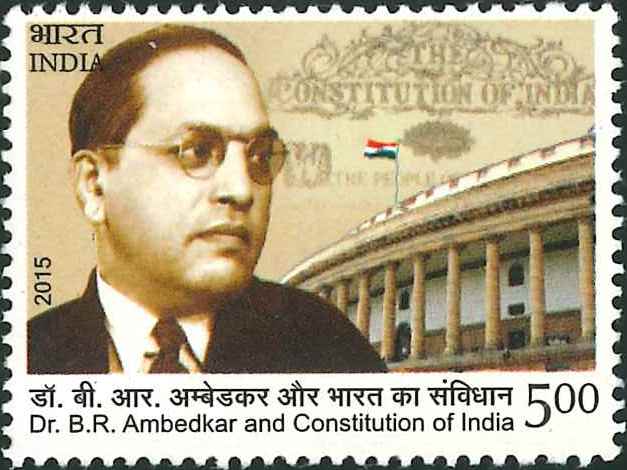
Dr. B.R. Ambedkar and Constitution of India
A commemorative postage stamp on the 125th Birth Anniversary of Dr. Bhimrao Ramji Ambedkar, chairman of the drafting committee of the Indian Constitution :
 Issued by India
Issued by India
Issued on Sep 30, 2015
Issued for : The Country is celebrating the 125th Birth year of Dr. B.R. Ambedkar and the Department of Posts is happy to issue a commemorative postage stamp on this occasion.
Credits :
Stamp/FDC : Brahm Prakash
Cancellation : Alka Sharma
Type : Stamp, Mint Condition
Colour : Multi colour
Denomination : 500 Paise
Stamps Printed : Wet Offset
Printing Process : 500 Paise
Printer : Security Printing Press, Hyderabad
Name : Bhimrao Ramji Ambedkar
Born on Apr 14, 1891 at Mhow, Central Provinces, British India [now in Madhya Pradesh, India]
Died on Dec 6, 1956 at Delhi, India
About :
- The life of Dr. Bhimrao Ambedkar, born on 14th April, 1891 in a Mahar family, was marked by struggles but he proved that every hurdle in life can be surmounted with talent and firm determination. The biggest barrier in his life was the caste system adopted by the Hindu society according to which the family he was born in was considered ‘untouchable’. After graduating from Elphinstone College Bombay in 1912, he did his higher studies at Columbia University, USA where he was awarded Ph.D. Later, he joined the London School of Economics and Political Science and obtained the degree of D.Sc. (Eco) and was eventually called to the Bar from Gray’s Inn.
- In 1927, Dr. Ambedkar led the Mahad March at the Chowdar Tank at Colaba, near Bombay, to give the untouchables the right to draw water from a public tank. This marked the beginning of his crusade against the practice of discrimination in the society. The temple entry movement launched by Dr. Ambedkar in 1930 at Kalaram temple Nasik is another landmark in his struggle for human rights and social justice.
- On 24th September 1932, Dr. Ambedkar and Gandhiji reached an understanding, which came to be known as the Poona Pact. The Pact carved out a clear and definite position for the downtrodden on the political scene of the country. It opened up opportunities of education and government service for them and also gave them a right to vote.
- Dr. Ambedkar attended all the three Round Table Conferences in London and each time, forcefully projected his views in the interest of the ‘untouchables’.
- Dr. Ambedkar, organized the Independent Labour Party, participated in the provincial elections, and was elected to the Bombay Legislative Assembly.
- In 1947, when India became Independent, the first Prime Minister Pt. Jawaharlal Nehru, invited Dr. Ambedkar, who had been elected as a Member of Constituent Assembly from Bengal, to join his Cabinet as a Law Minister. However, Dr. Ambedkar had differences of opinion with the Government over the Hindu Code Bill, which led to his resignation as Law Minister.
- On August 29th 1947 Dr. Ambedkar was appointed the Chairman of the Drafting Committee that was constituted by Constituent Assemble to draft a Constitution for Independent India. Dr. Ambedkar played a seminal role in the framing of the Indian Constitution. He used his vast experience and knowledge in drafting the Constitution. In his capacity as the Chairman of the Drafting Committee, he hammered out a comprehensive workable Constitution. He gave free India its legal framework, and the people, the basis of their freedom.
- Ambedkar was a champion of fundamental rights, and Part III of the Indian Constitution guarantees the fundamental rights to the citizens. Some of the fundamental rights contained in Articles 15(2), 17, 23 and 24 are also enforceable against individuals as they are very significant rights relating to the prohibition of discrimination on grounds of religion, race, caste, sex or place of birth etc. The text prepared by Ambedkar provided constitutional guarantees and protections for a wide range of civil liberties for individual citizens, including freedom of religion, the abolition of untouchability and outlawing all forms of discrimination. Dr. Ambedkar argued for extensive economic and social rights for women. Dr. Ambedkar‘s social democracy comprised politicians, political parties with high standards of political morality, honesty and integrity and strong and highly responsible Opposition party or parties committed to the cause of the downtrodden and depressed classes. The Preamble of the Indian Constitution echoes the principles of parliamentary democracy.
- In 1948, Dr. Ambedkar completed the draft of the Constitution and presented in the Constituent Assembly. In November 1949, this draft was adopted with very few amendments and came into force on January 26, 1950 marking the beginning of a new era in the history of India. Speaking after the completion of his work, Ambedkar said: “I feel the Constitution is workable; it is flexible and it is strong enough to hold the country together both in peace time and in war time“.
- On October 14, 1956 Baba Saheb Ambedkar embraced Buddhism along with many of his followers. The same year he completed his last writing ‘Buddha and His Dharma‘. On 6th December, 1956, Baba Saheb Dr. B.R. Ambedkar attained ‘Mahaparinirvan‘.
- In 1990, Dr. B.R. Ambedkar, the chief architect of our Constitution, was bestowed with Bharat Ratna.
- Text : Based on the material provided by the proponent.


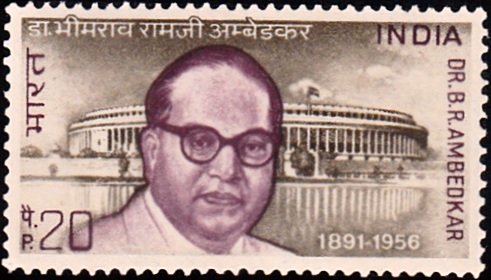
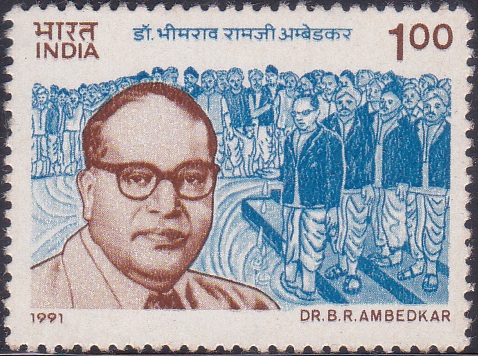
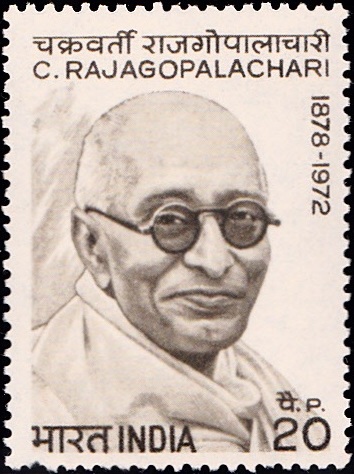
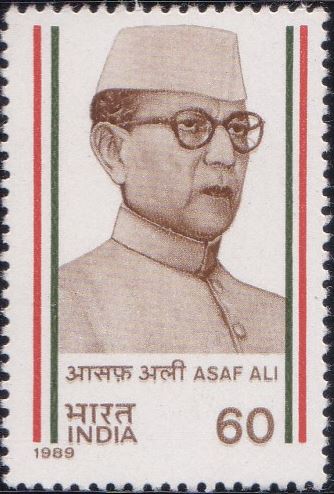
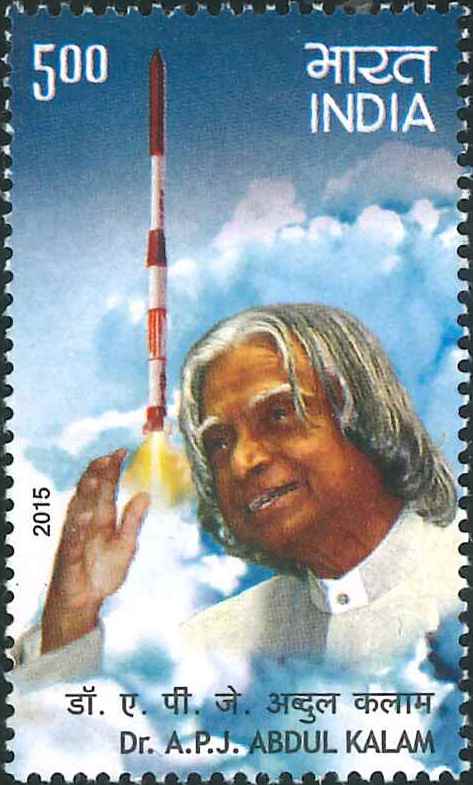
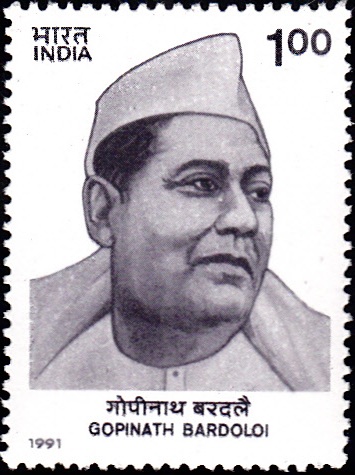
Correction
The Mahad Satyagrah at Chavdar Tale (Pond) was performed by Dr. B.R. Ambedkar at Mahad and not Mumbai.
Chavdar Tale (pronounced as ta+ley) was a pond which was restricted to the lower castes, Dr. B.R. Ambedkar performed the satyagrah by drinking water from this pond.
[…] took the oath of office as a Judge of the Federal Court later known as the Supreme Court when the Constitution of India came into force on 26th January 1950. Justice Mehr Chand Mahajan took over as the third Chief […]
[…] the basic economic and industrial infrastructure of the country and also left his mark on the Indian Constitution as a member of the Drafting […]
[…] as one of the most revered monuments of Buddhism. It is at this place, the architect of the Indian Constitution, Dr. Babasaheb Ambedkar, embraced Buddhism with nearly 4 lakhs of his followers on 14 October […]
[…] Survey of India, the principal mapping agency of the country is celebrating its 250th anniversary in year 2017. Origin of the Survey of India can be traced back to Year 1767, when Major James Rennell was appointed as the Surveyor General of Bengal. It is the oldest scientific department in India and one of the oldest survey establishments in the world. Survey of India also has the distinct honour of printing the first Postage Stamp of India and the first copy of the Constitution of India. […]
[…] nationalist movement had asserted the right of the Indian people to shape their own destiny. The Constitution which came in force on 26th January 1950, was designed to be an instrument of India’s social and […]
[…] nationalist movement had asserted the right of the Indian people to shape their own destiny. The Constitution which came in force on 26th January 1950, was designed to be an instrument of India’s social and […]
[…] nationalist movement had asserted the right of the Indian people to shape their own destiny. The Constitution which came in force on 26th January 1950, was designed to be an instrument of India’s social and […]
[…] It is also used in Nepal as the official calendar. In the Hindi version of the Preamble of Constitution of India, the date of adoption of the Constitution, 26 November 1949, is presented in Vikram Samvat. It is a […]
[…] period by an Indian citizen in any of the 15 Indian languages included in the VIII Schedule to the Indian Constitution. It has become the symbol of the comprehensive vision of Indian literature. This special postage […]
[…] its children as the most precious resource as is enshrined in the provisions laid down in the constitution, the National Policy for children and the national development plans. Numerous national programmes […]
[…] equality of opportunity, genuine freedom, respect for religious and moral values enshrined in the Constitution of India may prevail and the possibility of living a fully human existence may be open before […]
[…] 1946 he was appointed to the Experts’ Committee for drafting the Constitution of India and elected to the Constituent Assembly. In 1947, he was appointed Agent-General to the […]
[…] Minister of the State. He was also a Member of the Indian Constituent Assembly, a signatory to the Indian Constitution and in 1948-49, a member of the Indian delegation to the United […]
[…] Indian Independence, attending the Simla Conference in 1945. He contributed to the framing of the Constitution as a member of the Constituent Assembly of India, its committees and sub committees. At the AICC […]
[…] ex-officio member of the Constituent Assembly, and he played a notable part in the drafting of the Constitution. As he declined to stand for election in Bombay in 1952, he was elected by the Bombay Legislative […]
[…] of the few countries to have specifically referred to the need for environmental protection in its Constitution. The Directive Principles of State Policy enjoins, “the State shall endeavour to protect and […]
[…] He served as Member of the Tamil Nadu (Madras) Assembly from 1946 to 1952. He was later elected to the Constituent Assembly. As a member of the Constituent Assembly he played a prominent role in the shaping of the Indian Constitution. […]
[…] to the transaction of business, Rajya Sabha has effectively discharged its role mandated by the Constitution. Rajya Sabha has limited power in financial matters but the role assigned to it in this regard is […]
[…] IV of the Constitution spells out the Directive Principles of State Policy that embody the aims and objects of a […]
[…] country in 1929. He took an active part in the Committee that met under Motilal Nehru to frame the Constitution for […]
[…] comprising outstanding literary works in all the 15 languages enshrined in the VIII Schedule of the Constitution of India. Winners of the award over the years have all shared one common quality of being truly creative in […]
[…] independence, when the new Constitution of India came into force, Article 124 provided for the establishment of the Supreme Court of India […]
[…] principle of gender equality is enshrined in the Indian Constitution in its Preamble, Fundamental Rights, Fundamental Duties and Directive Principles. The Constitution […]
[…] Indian Constitution that was being formulated at the time the Universal Declaration was adopted by the General Assembly […]
[…] culture and have been strengthened by the sacrifices made by women during the freedom struggle. The Indian Constitution has recognised the need for equality between the sexes. Whenever the State finds any criminal or […]
[…] public speaker and a person as deeply interested in literature as in law. On the enactment of the Constitution of India in 1950, problems without precedence were placed before Courts of Law for solution. Justice […]
[…] commitment to the cause and well-being of its children is enshrined in its Constitution. The country has upheld its social and moral responsibility towards the needs and rights of the […]
[…] Bhimrao Ramji Ambedkar, the chief architect of Indian Constitution and Champion of Human Rights was born on 14th April, 1891 in a family belonging to the untouchable […]
[…] important in programmes directed to rural areas. Besides the 14 major languages mentioned in the Indian Constitution, AIR broadcasts in English, Dogri and Sindhi as also in 51 dialects and 82 tribal […]
[…] and Chairman of the Drafting Committee, Dr. Ambedkar played a leading role in the framing of the Indian Constitution. As an authority on Constitutional Law, his influence on politics, social reform, education and […]
[…] as education, politics, media, art and culture, service sectors, science and technology etc. Our Constitution guarantees equal rights for men and women. The Constitution is firmly grounded in the principles of […]
[…] and millions of people went to the polls to exercise the democratic right granted to them by the Constitution of India to choose the country’s legislators. Since then, Uttar Pradesh legislature has been […]
[…] on the successful completion of the first 25 years of the Republic and of the working of our Constitution and Parliament by bringing out a commemorative stamp on the occasion of the Silver Jubilee […]
[…] to power. For this, it created the Election Commission of India, under Article 324 of the Constitution, vesting in it the superintendence, direction and control of elections to Parliament and […]
[…] day cover design features Dr. B.R. Ambedkar who played the pivotal role in the drafting of the Constitution of India as chairman of the Drafting Committee and has been termed, the chief architect of the Indian […]
[…] 1935, the ideal of universal adult suffrage was realised only by the inauguration of the present Constitution in […]
[…] the coming into force of the Constitution of India on 26 January 1950, the name of the Department was changed to “Parliament Secretariat“. […]
[…] was the upliftment of the lower castes that led to the banning of ‘untouchability’ in the Indian Constitution. Three wise Monkeys representing the principles “see no evil, hear no evil, speak no evil” […]
[…] Constituent Assembly, representing the Princess of Central India and worked on the framing of the Constitution. In 1948 he was appointed Governor of […]
[…] of small land holders, traditional artisans and agricultural labourers in 1949, when the Constitution of India was being drafted, he wrote an article “Rojgaracha Hakk” (Right to Employment) and […]
[…] gave statutory recognition, the GOI Act-1935 determined the status of Auditor General. The Constitution of India in 1950 accorded a position of eminence to the C&AG who, as summed up by Dr. B.R. Ambedkar was […]
[…] Constitution of India ensures equality, freedom, justice and dignity of all individuals and implicitly mandates […]
[…] sincere social worker and philanthropist, he was a pioneer and forerunner to Dr. B.R. Ambedkar and Shri Periyar and campaigned against caste system and untouchability and advocated social […]
[…] Constitution of India is premised on multiple fundamentals of which equality and justice are the prominent […]